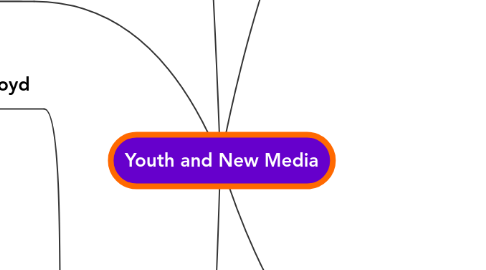
1. social changes
1.1. friendship
1.1.1. cyberbullying
1.1.1.1. http://www.stopcyberbullying.org/
1.1.2. privacy
1.1.2.1. http://xblock.isafe.org/images/swf/vodcast_1.7/swf
1.2. sexuality
1.2.1. online
1.2.1.1. http://www.thenationalcampaign.org/sextech/PDF/SexTech_Summary.pdf
1.2.1.2. internet porn
1.2.1.2.1. http://www.eurekalert.org/pub_releases/2007-02/uoa-oit022307.php
1.2.2. dating and relationships
1.2.2.1. sexting
1.2.2.1.1. http://socialnomics.net/2009/12/04/13-are-sexting/
1.3. identity
1.3.1. self-expression
1.3.1.1. http://www.uktribes.com/
1.3.1.2. online persona
1.3.1.2.1. http://teen.secondlife.com/
1.3.2. independence
1.3.2.1. reputation
1.3.2.1.1. gossip
1.3.2.2. addiction
1.3.2.2.1. warning signs
1.3.3. community
1.3.3.1. activism
1.3.3.1.1. http://www.dosomething.org/
1.3.3.1.2. http://www.movements.org/
2. research
2.1. Danah Boyd
2.1.1. http://www.danah.org/
2.1.1.1. blog
2.1.1.1.1. http://www.zephoria.org/thoughts/
2.1.1.2. Book: Hanging Out, Messing Around, and Geeking Out by Danah Boyd
2.1.1.2.1. http://mitpress.mit.edu/catalog/item/default.asp?ttype=2&tid=11889
2.1.2. Report: Living and Learning with New Media: Digital Youth Project (MacArthur Foundation)
2.1.2.1. http://digitalyouth.ischool.berkeley.edu/files/report/digitalyouth-WhitePaper.pdf
2.2. Pew Internet & American Life Project
2.2.1. Social Media and Young Adults
2.2.1.1. http://www.pewinternet.org/Reports/2010/Social-Media-and-Young-Adults.aspx
2.2.1.2. http://pewinternet.org/Presentations/2010/Feb/Department-of-Commerce.aspx
2.2.2. Teens and Sexting
2.2.2.1. http://www.pewinternet.org/Reports/2009/Teens-and-Sexting/Overview.aspx?r=1
2.2.3. Millennials: A Portrait of Generation Next
2.2.3.1. survey
2.2.3.1.1. http://pewresearch.org/millennials/
2.3. Keiser Family Foundation
2.3.1. News Release
2.3.1.1. http://www.kff.org/entmedia/entmedia012010nr.cfm
2.3.2. Report: Generation M2: Media in the Lives of 8 - 18 Year Olds
2.3.2.1. http://www.kff.org/entmedia/8010.cfm
2.4. methods
2.4.1. survey
2.4.1.1. Chart: Who Participates And What People Are Doing Online (BusinessWeek)
2.4.1.1.1. http://www.businessweek.com/magazine/content/07_24/b4038405.htm
2.4.1.2. Media Use (NY Times)
2.4.1.2.1. http://graphics8.nytimes.com/images/blogs/learning/pdf/2010/20100122mediasurvey.pdf
2.4.2. analysis
2.4.2.1. Create a Graph (Kids' Zone)
2.4.2.1.1. http://nces.ed.gov/nceskids/createagraph/default.aspx
2.4.3. visual mapping
2.4.3.1. http://vue.tufts.edu/about/index.cfm
2.4.3.1.1. http://www.mindmeister.com/
2.4.4. final report
2.4.4.1. http://www.edweb.net/fimages/op/K12Survey.pdf
2.5. HRSB external research
2.5.1. http://www.hrsb.ns.ca/content/id/540.html
2.5.2. preliminary survey
2.5.2.1. https://www.surveymonkey.com/s/FZYCWWY
2.6. contact me
2.6.1. http://hrsbstaff.ednet.ns.ca/forfad
2.6.1.1. [email protected]
3. education
3.1. context
3.1.1. peer-based
3.1.1.1. self-directed
3.1.2. community
3.1.2.1. global
3.1.2.1.1. civic engagement
3.2. literacy
3.2.1. http://www.wordle.net/
3.2.2. http://newmedialiteracies.org/
3.2.3. http://pbskids.org/read/files/PBS_CPS_Report.pdf
3.3. home - school relationship
3.3.1. http://www.futurelab.org.uk/projects/home-school-relationships
3.4. research
3.4.1. Digital Ethnography (Kansas Stat University)
3.4.1.1. http://mediatedcultures.net/ksudigg/
3.4.2. FRONTLINE: digital nation (PBS)
3.4.2.1. http://www.pbs.org/wgbh/pages/frontline/digitalnation/view/
3.4.3. Tomorrow's Students: Are We Ready for the New 21st-Century Learners? (Educause)
3.4.3.1. http://www.educause.edu/Resources/TomorrowsStudentsAreWeReadyfor/162128
3.5. art
3.5.1. http://www.australiacouncil.gov.au/research/arts_participation/reports_and_publications/apr
4. media devices
4.1. computer
4.1.1. Internet
4.1.1.1. SNS
4.1.1.1.1. Facebok
4.1.1.2. YouTube
4.1.1.2.1. music video
4.2. mobile
4.2.1. http://www.tjf.or.jp/takarabako/PDF/TB21_JCN.pdf
4.2.2. http://www.mobilebehavior.com/work/#singtel-youth-portal
4.2.3. http://www.mobl21.com/
4.3. game system
4.3.1. software
4.3.1.1. multiplayer
4.3.1.2. genre
4.3.1.2.1. fantasy
4.4. digital camera
4.4.1. photo
4.4.1.1. video
4.4.1.1.1. webcam
4.5. future technology
4.5.1. wireless
4.5.1.1. http://xblock.isafe.org/images/swf/vodcast_1.8.swf
4.5.1.2. http://civic.mit.edu/projects/c4fcm/community
4.5.2. web2.0
4.5.2.1. http://www.web2summit.com/web2009/public/schedule/detail/10626
4.5.3. free access
4.5.4. renewable energy
4.5.4.1. solar power
5. media use
5.1. communication
5.1.1. connecting
5.1.1.1. social networks
5.1.2. texting / instant messaging
5.1.2.1. http://www.thatsnotcool.com/
5.1.2.2. http://www.texted.ca/app/en/
5.1.3. sharing
5.1.3.1. photos
5.2. consumption
5.2.1. time
5.2.1.1. multitasking
5.2.1.1.1. memory
5.2.1.1.2. effectiveness
5.2.1.2. FRONTLINE: Growing Up Online (PBS)
5.2.1.2.1. http://www.pbs.org/wgbh/pages/frontline/kidsonline/
5.2.2. recreation
5.2.2.1. interests
5.2.2.1.1. activities
5.2.3. money
5.2.3.1. online shopping
5.2.3.2. advertising
5.2.3.2.1. marketing
5.2.3.2.2. Graham Brown
5.2.3.2.3. FRONTLINE: The Merchants of Cool (PBS)
5.3. production
5.3.1. creating/ remixing
5.3.1.1. web design
5.3.1.1.1. blogging
5.3.1.2. music
5.3.1.2.1. video
5.3.1.3. game / animation
5.3.1.3.1. http://www.juhaterho.fi/drawings/animations/
5.3.1.3.2. http://scratch.mit.edu/
5.4. cyber safety
5.4.1. guidelines and boundries
5.4.1.1. parental control
5.4.1.1.1. values
5.4.1.2. age restrictions
5.4.1.2.1. http://www.freepatentsonline.com/y2008/0281710.html
5.4.2. web issues
5.4.2.1. http://www.bewebaware.ca/
5.4.3. http://xblock.isafe.org/
